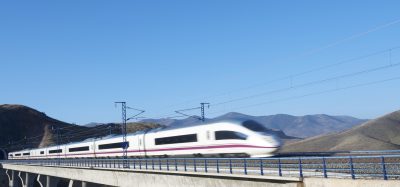Promoting the internationalisation of Spanish railway technology
Posted: 19 September 2012 | | No comments yet
Since my appointment as CEO of Adif, one of my main strategic priorities has been to drive forward the internationalisation of Spanish railway technology and its companies, and to reinforce the ‘Spanish Brand’ on an international basis. By doing so, the international activity of Adif must be, and is, an important pillar of the company’s strategy because it consolidates our presence in the global arena and also paves the way to achieve new markets and, therefore, new economic resources.
In this sense, Adif, as infrastructure manager, works actively with Spanish companies to support them in their internationalisation strategies to help contribute to the projection of the railway sector abroad.
In my opinion, Spain’s experience of railway development would serve as a good example for numerous countries, especially in the technological field of construction and management of high-speed lines. We are proud of the support that we can give for the creation of Spanish consortiums for the design and construction of infrastructure projects abroad.
Since my appointment as CEO of Adif, one of my main strategic priorities has been to drive forward the internationalisation of Spanish railway technology and its companies, and to reinforce the ‘Spanish Brand’ on an international basis. By doing so, the international activity of Adif must be, and is, an important pillar of the company’s strategy because it consolidates our presence in the global arena and also paves the way to achieve new markets and, therefore, new economic resources. In this sense, Adif, as infrastructure manager, works actively with Spanish companies to support them in their internationalisation strategies to help contribute to the projection of the railway sector abroad. In my opinion, Spain’s experience of railway development would serve as a good example for numerous countries, especially in the technological field of construction and management of high-speed lines. We are proud of the support that we can give for the creation of Spanish consortiums for the design and construction of infrastructure projects abroad.
Since my appointment as CEO of Adif, one of my main strategic priorities has been to drive forward the internationalisation of Spanish railway technology and its companies, and to reinforce the ‘Spanish Brand’ on an international basis. By doing so, the international activity of Adif must be, and is, an important pillar of the company’s strategy because it consolidates our presence in the global arena and also paves the way to achieve new markets and, therefore, new economic resources.
In this sense, Adif, as infrastructure manager, works actively with Spanish companies to support them in their internationalisation strategies to help contribute to the projection of the railway sector abroad.
In my opinion, Spain’s experience of railway development would serve as a good example for numerous countries, especially in the technological field of construction and management of high-speed lines. We are proud of the support that we can give for the creation of Spanish consortiums for the design and construction of infrastructure projects abroad.
A great example of this development is the recent award to a Spanish consortium (which Adif is part of) for the ‘Haramain Project’ to build the railway superstructure and develop the high-speed rail link between Mecca and Medina in Saudi Arabia, marking a tremendous success for Spain. Winning this project has allowed us to consolidate ourselves as a reference industry in the international highspeed railway sector. Therefore, Adif’s crucial participation in the Spanish consortium for this project will be responsible for the manage – ment of the superstructure and railway equipment of the 444km-long high-speed section, and for the development of all passenger stations for 12 years.
In addition to this important project, Adif is also currently involved in a variety of railway developments in Mexico, the United Kingdom, Turkey, Poland, Morocco, Colombia, Chile, India, Brazil, the United States and Saudi Arabia, to name just a few.
We also strongly support projects in Russia, where we have signed agreements to cover diverse areas. This emphasises Russian Railways’ interest in our experience of the construction and management of highspeed lines, gauge change technology, and passenger stations management, as well as the identification of Public-Private Partnership (PPP) solutions.
Among the plans in Russia, the construction project of the Moscow to St Petersburg highspeed line stands out. It’s a project which the consortium of Spanish companies can really excel at and will help to maintain an excellent working relationship with Russian Railways.
Over in the United States of America – a country that is showing great interest in Spanish railway technology – Adif is supporting and sharing experience and knowledge in the development of high-speed lines, especially in the areas of construction, quality control, management and track maintenance. This interest has materialised in numerous official delegations visiting Spain from representatives of the Secretariat of Transports, of the Congress or the Senate, up to members of the Federal Administration of Railways and delegates of the different States.
The aforementioned international activities are based on Spain’s strong portfolio of products and railway patents that can be offered for the modernisation of railway systems throughout the world.
Also to bear in mind is the technological field. Our network incorporates the latest advances in R+D for innovation and technology transfer processes in infrastructure, signalling, electrification and rolling stock. This all makes Spain stand out on a global scale for the design of the most modern high-speed railway projects; the technologically more advanced systems of communication and signalling of the market; the aptitude to put in service and to maintain efficient and interoperable infra – structures at competitive prices, and patent systems of management of traffic that guarantee safety and efficiency.
The Spanish railway sector settles in the technological avant-garde across the development of network interoperability, and in the seamless integration of the best railway technologies, and has managed to stand out in the management of complex projects, assuring quality, price and performance.
We also stand out in systems of automatic gauge change – an area of big interest for countries like Russia – which, like Spain, also uses a different gauge from the UIC standard.
Spain is a leader in the railway traffic management area, thanks to the DaVinci System, which has already been implanted by the Moroccan and Lithuanian railways companies, among others. Spain is also the European country with the biggest implantation of the common system of signalling ERTMS, with more than 1,700km provided.
The DaVinci System places between the most advanced traffic management systems of the world, integrating all the elements of a modern railway’s Center of Regulation and Control in one application. On the other hand, Adif is a leader in the field of railway electrification, with the development of an overhead power cable entirely Spanish under the denomination C-350, and the new developments in protection electronic engineering in level-crossings, which have helped increase the safety in these strategic points of the railway network.
A key element of Adif’s innovation strategy is the Railway Technologies Centre in Malaga, conceived to focus on railway technological development across R+D projects.
For many years, Spain has been leading the way to highlight railway transportation as a future mode of transport. In our network of high-speed lines, Adif manages almost 2,900km of new services and has approximately 1,500km of lines in different execution phases, as well as another 900km in study or project phases, with an investment realised (at 31 December 2011) at an approximate value of €39,500 million.
On our conventional network, we manage more than 11,000km of lines, among which our commuter networks are a vital element for the mobility in our main cities.
To maintain this effort in the current environ ment of turmoil and economic downturn, Adif is in charge of the management and development of the Spanish railway infrastructure and must plan investment and expenses in a responsible and efficient manner to achieve the maximum economic and social profitability of our network, along with searching for new markets, especially on an international basis.
It is necessary to point out that half of the budget of the Public Works Ministry is assigned to railway development, and Adif, who will manage most of the investment by means of cooperation partnerships and other strategies that allow to increase the self-financing and the identification of new sources of income, to keep on contributing to the activation of the economy and to the creation of highly skilled new employment.
In investment figures, the main asset in 2012, €4,187 million, will be assigned to the deployment of the high-speed networks, with the priority targets to impulse the connections of Madrid–Galicia, the Vitoria–Bilbao– San Sebastián high-speed line, Barcelona –French border high-speed line and the Albacete–Alicante link.
Another of our priorities is the Med – iterranean Corridor for freight transport and passengers, designed with the implementation of a third rail on the track of existing routes to reduce the costs and to shorten to the maximum putting in service period. This infrastructure, that receives a notable impulse with a due investment for €1,342 million, will suppose an important economic stimulus for the whole country and for the communities of Andalusia, Murcia, Castilla-La Mancha, Valencia Community and Catalonia.
On the other hand, there will be refurbishment and maintenance works on the conventional network. The investment necessary for the railway network management and maintenance, on behalf of the State that realises Adif, supposes €740 million, which would assure the suitable service standard to the users.
Finally, on the topic of mobility and the commuter transport system, we will keep on pushing the deployment of the network, increasing accessibility, capacity and safety, as well as new stations and interchangers. For example, work has already begun in Madrid for line C-4 of the system of management of railway traffic ERTMS, a pioneering performance in Europe, and that is foreseen that continues with the implantation of the system in Madrid and Barcelona commuter systems.
About the author
With a degree in Economics, Enrique Verdeguer Puig was Minister of Economy, Trade and Industry for the regional government of Valencia. He has previously been Director of the Spanish Institute for Foreign Trade (ICEX) and Director of the Industrial Products and Technology Division. Enrique Verdeguer Puig has also worked at the Spanish Embassy in Rabat and was Deputy Director-General of studies on the external sector at the Ministry of Economy.







